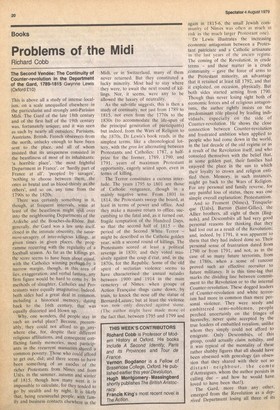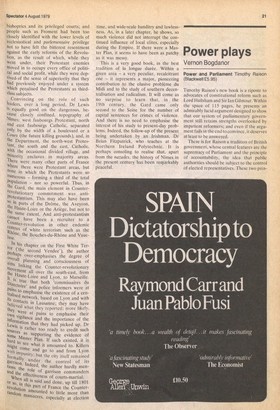Problems of the Midi
Richard Cobb
The Second Vendee: The Continuity of Counter-revolution in the Department of the Gard, 1789-1815 Gwynne Lewis (Oxford £10) This is above all a study of intense localism, on a scale unequalled elsewhere in the particularist and strongly anti-Parisian Midi. The Gard of the late 18th century and of the first half of the 19th century was, fortunately unique; and it was seen as such by nearly all outsiders: Parisians, Austrians, British, French observers from the north, unlucky enough to have been sent to the place, and all of whom insisted that its uniqueness consisted in the beastliness of most of its inhabitants: 'a horrible place', 'the most frightful Department in France'. or 'hardly part of France at all', 'peopled by savages', 'nothing to choose between them, the ones as brutal and as blood-thirsty as the others', and so on, any time from the 1790s to the 1820s.
There was certainly something in it, though, at frequent intervals, sonic at least of the beastliness might spill over into the neighbouring Departments of the Ardeche and the Bouches-du-Rhone. But, generally, the Gard was a law unto itself, closed in the intimate obscenity, the tutotement-savagery of inter-religious killings, at given times in given places. the programme recurring with the regularity of a football season. As far as the killings go, the score seems to have been about equal: with the Catholics winning perhaps by a narrow margin, though, in this area of lies. exaggeration, and verbal fantasy, any firm figure would be hard to come by. In methods of slaughter, Catholics and Protestants were equally imaginative. Indeed, both sides had a great deal in common. including a historical memory,, dating back to the 16th century, that was equally distorted and blown up.
Why, one wonders, did people stay in such an awful place? Because, presumably, they could not afford to go anywhere else, for, despite their different religious affiliations, and consequent conflicting family memories, most participants in the recurrent massacres shared a common poverty. Those who could afford to get out, did; and there seems to have been something of an exodus of the richer Protestants from Nimes and from Uzes, in the summer, autumn and winter of 1815, though how many went it is impossible to calculate, for they tended to go by stealth and by night. It is likely that, being resourceful people, with family and business contacts elsewhere in the Midi, or in Switzerland, many of them never returned. But they constituted ,a lucky minority. Most had to stay where they were, to await the next round of killings. Nor, it seems, were any to be allowed the luxury of neutrality.
As the sub-title suggests, this is then a study of continuity, not just from 1789 to 1815, not even from the 1770s to the 1830s (to accommodate the life-span of the principal generation of participants) but indeed, from the Wars of Religion to the 1870s. Dr Lewis's book reads, in the simplest terms, like a chronological lottery, with the gros lot alternating between Protestants and Catholics: 1787, a halfprize for the former, 1789, 1790, and 1791, years of maximum Protestant opportunity, eagerly seized upon, even in terms of killing.
The Terror constitutes a curious interlude. The years 1795 to 1801 are those' of Catholic vengeance, though in a mainly negative sense. From 1801 to 1814, the Protestants sweep the board, at least in terms of power and office. And they make a massive return to office, succumbing to the fatal and, as it turned out, fragile temptation of the Hundred Days, so that the second half of 1815 — the period of the Second White Terror — might be described as the Catholic golden year, with a second round of killings. The Protestants scored at least a political revenge in 1830; and they voted massively against the coup d'etat, and, in the 1870s, for the Republic. Some of the old spirit of sectarian violence seems to have characterised the annual nazades between 1900 and 1914 in the main cemetery of Nimes. when groups of Action Frangaise thugs came down, by train, to knock the nose off the statue of Bernard-Lazare; but at least the violence was now only directed against stone. (The author might have made more of the fact that, between 1795 and 1799 and again in 1815-6, the small Jewish community of Nimes was often as much at risk as the much larger Protestant one).
Dr Lewis illustrates the increasing economic antagonism between a Protestant patriciate and a Catholic artisanate in the last years of the ancien regime. The coming of the Revolution, in crude terms — and these matter in a crude community — gave the force of arms to the Protestant minority, an advantage that it retained at least till 1792, and that it exploited, on occasion, physically. But both sides started arming from 1790. Though thus never losing sight both of economic forces and of religious antagonisms, the author rightly insists on the predominant role played by leading individuals, especially on the side of Counter-revolution. He shows the close connection between Counter-revolution and frustrated ambition when applied to people who had come down in the world, in the last decade of the old regime or as a result of the Revolution itself, and who consoled themselves with the belief that, in some golden past, their families had enjoyed the place in the sun to which their loyalty to crown and religion entitled them. Memory, in such instances, might go back to the Wars of Religion. For any personal and family reverse, for any painful loss of status, there was one simple overall explanation: Protestantism.
And so Froment (Nimes), Trinquelaque (Uzes), Barron (Saint-Gilles), the Allier brothers, all eight of them (Bagnols), and Descombies all had very good personal reasons for thinking that they had lost out as a result of the Revolution; and, indeed, by 1791, it was apparent to them that they had indeed done so. Their personal sense of frustration dated from 1790 or from 1791, and not, as in the case of so many future terrorists, from the 1780s, when a sense of rancour proved such an effective recruiter to future militancy. It is this time-lag that marks the dividing line between commitment to the Revolution or to the internal Counter-revolution. These dogged leaders of Counter-revolution and white terrorism had more in common than mere personal violence. They were seedy and embittered semi-noblemen, people perched uncertainly on the fringes of hierarchy, never quite accepted by the true leaders of embattled royalism, unlike whom they simply could not afford to emigrate. Only Descombies, of this group, could actually claim nobility, and it was typical of the mentality of these rather shabby figures that all should have been obsessed with genealogy (an obsession that they shared with their not so distant neighbour, the cornte d'Antraigues, whom the author persists in calling due — and how he would have loved to have been that!). The Gard, more than any other, emerged from the Revolution as a deprived Department losing all three of Its bishoprics and its privileged courts; and people such as Froment had been too closely identified with the lower levels of ecclesiastical and parlementaire privilege not to have felt the bitterest resentment against the early reforms of the Revolution, as the result of which, while they went under, their Protestant enemies moved in to occupy every office of political and social profit, while they were deprived, of the sense of superiority that they had previously enjoyed under a system Which penalised the Protestants as thirdclass subjects.
Convincing on the role of such leaders, over a long period, Dr Lewis is equally good on the dangerous, because closely confined, topography of Nimes: west faubourgs Protestant, north and east faubourgs Catholic, separated Only by the width of a boulevard or a Coars (the future killing grounds), and, in the Department, the north-west Protestant, the south and the east, Catholic, with the occasional divided village, and minority enclaves in majority areas. There were many other parts of France where there were Protestant areas, but none in which the Protestants were so numerous — forming a third of the total PoPulation — nor so powerful. Thus, in the Gard. the main element in Counterrevolutionary commitment was antiprotestantism, This may also have been so in parts of the DrOme, the Aveyron, the Haute-Loire or the Ariege, but not to the same extent. And anti-protestantism cannot have been a recruiter to a Counter-revolution in other endemic centres of white terrorism such as the ,ithOne, the Bouches-du-Rhone and Vauc[ust.
in his chapter on the First White Terr°r Cthe second Vendee'), the author Perhaps over-emphasises the degree of Overall planning and consciousness of aims linking the Counter-revolutionary movement all over the south-east, from e liaute-Loire and Lyon, to Marseille. iS true that both `commissaires du Iiirectoire and police informers were at Pains to emphasise the existence of a centtrdlised network, based on Lyon and with s contacts in Lausanne; they may have helieved what they reported; more likely. IheY were at pains to emphasise their °,n‘v„fl vigilance and the importance of the tormation that they had picked up. Dr Lewis is rather too ready to credit such o sources as supporting the evidence of hard to Plan. If such existed, it is drd to see i what t amounted to. Killers with irn , and go to and from Lyon form•unity; hut the city itself remained ‘1..), under the control of its garrison. Indeed, the author hardly mentions the role of garrison commanders and the effectiveness of courts-martial. .r sW When all is said and done, up till 1801 SO, in this part of France the Counterrevolution amounted to little more than random massacres, especially at election time, and wide-scale banditry and lawlessness. As, in a later chapter, he shows, so much violence did not interrupt the continued influence of local elites, especially during the Empire. If there were a Master Plan, it seems to have been as patchy as it was messy.
This is a very good hook, in the best tradition of la longue duree. Within a given area — a very peculiar, recalcitrant one — it represents a major, pioneering contribution to the elusive probleme du Midi and to the study of southern decentralisation and radicalism. It will come as no surprise to learn that, in the 19th century, the Gard came only second to the Seine for the number of capital sentences for crimes of violence. And there is no need to emphasise the interest of his study to present-day problems. Indeed, the follow-up of the present being undertaken by an Irishman, Dr Brian Fitzpatrick, who. teaches at the Northern Ireland Polytechnic. It is perhaps consoling to realise that, apart from the nazades, the history of Nimes in the present century has been remarkably peaceful.



































 Previous page
Previous page